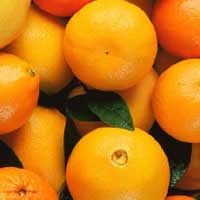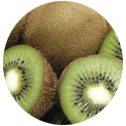 Full List of Fruits
Full List of Fruits  African cherry orange
African cherry orangeAfrican cherry orange
![]() Introduction of African cherry orange
Introduction of African cherry orange
Scientific name - Citropsis articulata
The African cherry orange endemic to Central and Western Africa, it is a small citrus fruit just about the size of a tangerine. It is used as a traditional herbal medicine in addition. The fruit is 2 or 3 centimeters long. Locally known as the omuboro, the species is typically a shrub, every so often a tree. With pointed leaflets, the leaves are up to 33 centimeters long. They are just about 2 centimeters long and the inflorescence is a cluster of flowers with four white petals and the style may be 1.5 centimeters lengthy.
The African cherry orange (Citrus sinensis) is a hybrid citrus fruit native to Africa. It is a cross between a sweet orange and a sour orange, and is a relative of the tangerine. The fruit has a thin, yellow-orange skin with a deep red flesh, and is smaller and rounder than a regular orange. The flavor is sweet and tangy, similar to a tangerine. The African cherry orange is a popular ingredient in salads, smoothies, juices, and desserts. It is also used to make jams and preserves. The juice of the African cherry orange is high in vitamin C, and the fruit is a good source of dietary fiber, folate, and antioxidants.
![]() Nutritional Value of African cherry orange
Nutritional Value of African cherry orange
There are several benefits using it and they are also known as Citropsis schweinfurthii. Compared to any other fruit, quite a few nutrition experts have affirmed the unusual nutritional benefits of the fruit together with its efficacy in the prevention and management of certain ailments.
Nutritional experts say that, this fruit contains 5 per cent of the daily recommended value per serving of vitamin C and vitamin A. It is also believed that the leaves of the fruit condensed glucose levels in diabetic rabbits, the same function that insulin in the human body act upon. Furthermore, one serving of cherry serves up to 2 per cent of iron, a mineral very important for oxygenating your body, that you need every day. They can also be consumed generously as a great source of phytochemical.
| Moisture | 66.67 % |
| carbohydrate | 78.34 % |
| Protein | 5.66% |
| fiber | 4.50 % |
| fat | 9.83 % |
| ash | 2.12 % |
| Total energy value | 420.42 % |
| ascorbic acid | 19.68 % |
| Anti-nutrients: | |
| oxalate | 4.95mg |
| saponins | 3.66 % |
| cyanogenic glycoside | 0.17 % |
| phytate | 0.02 % |
| tannins | 0.03 % |
![]() Health Benefits of African cherry orange
Health Benefits of African cherry orange
Preventing Heart disease.
Reducing Aging skin.
Manage diabetes.
Energizing Brain Cells.
The African cherry orange is a rounded orange, with a skin that is quite thick and deeply colored. The pulp of the fruit is juicy and sweet, with a pleasant aroma. It is used in a variety of ways.Fresh fruit is eaten as a snack or used to make juice, jams, and jellies. The rind and juice are also used to flavor a variety of dishes, and the dried peel can be used as a flavoring agent. The fruit is also used to make marmalades and candies, and is often used in desserts and drinks.
The African cherry orange is susceptible to several diseases, including citrus canker, citrus leaf miner,citrus black spot, and citrus blight.These diseases can be controlled through the use of fungicides and insecticides, and can be prevented by avoiding overcrowding of trees and providing good air circulation.The African cherry orange is an important source of food and nutrition in many parts of the world. The fruit is high in vitamins A and C, and is also a good source of dietary fiber.The fruit is also believed to help reduce the risk of certain cancers and heart disease.
![]() History of African cherry orange
History of African cherry orange
The African cherry orange (Citrus sinensis) is a citrus fruit native to Southeast Asia. It is widely grown in many countries in the tropics and subtropics, including Africa. It is a cross between a sweet orange and a mandarin, and is sometimes called a "blood orange" due to its dark red-orange color. The African cherry orange is a juicy, aromatic fruit with a distinctive flavor. It has a thin and easy-to-peel rind, and the flesh is a deep red-orange color. It is high in Vitamin C, and has a sweet-tart flavor with hints of berry, honey, and spice.
The history of the African cherry orange dates back to the 18th century. It is believed to have been introduced to the continent of Africa by Portuguese traders in the late 1700s. The fruit quickly became popular among African cultures, and was soon grown in many parts of the continent.In the 19th century, the African cherry orange was introduced to the United States and Europe. It quickly became popular in the United States, and was widely grown in California and Florida.It was also grown in Europe, especially Italy, where it is still widely cultivated today.



















